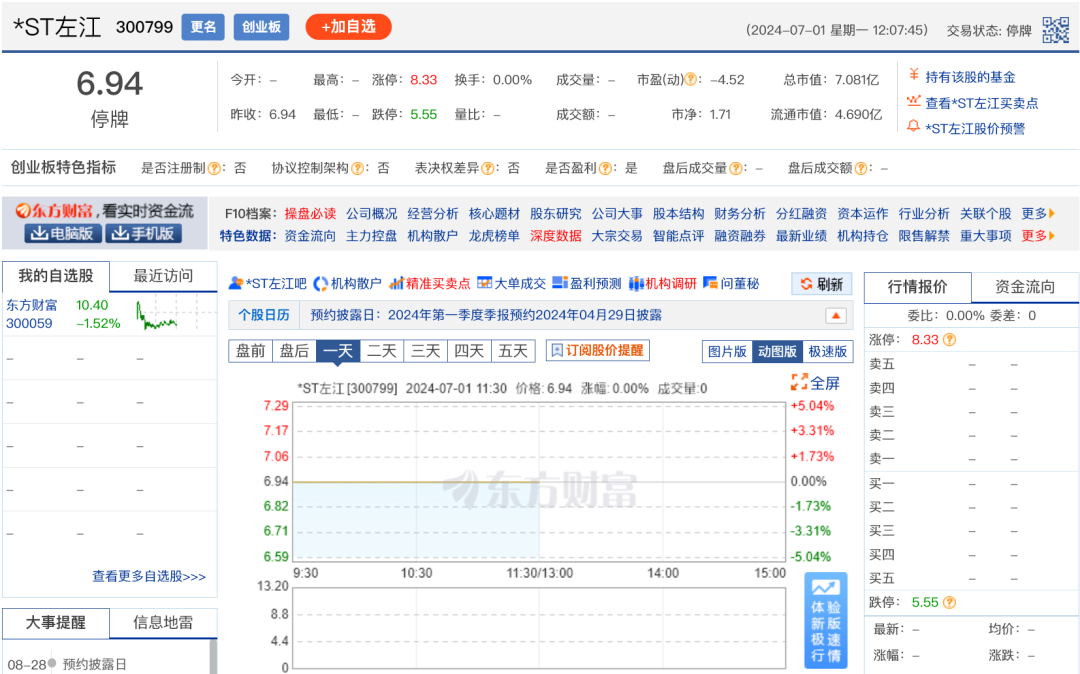Less than 5 years after listing in China, with a market value exceeding 30 billion yuan, Zuojiang Technology, once known as a "chip giant" and "competitor of NVIDIA," announced its delisting, and its stock price fell from 299.98 yuan to 6.94 yuan.
In regulatory documents, Zuojiang Technology stated that its stock will cease trading on the Shenzhen Stock Exchange on July 26th. Previously, the company was unable to submit a clean audit report for its 2023 financial performance, which prompted the Shenzhen Stock Exchange to take action to delist it.

According to reports, on the evening of June 28th, the Shenzhen Stock Exchange announced that * ST Zuojiang (Zuojiang Technology), which was once known as the "most expensive ST stock in history," will be delisted, but ultimately left the market in disappointment. The stock of Zuojiang Technology will enter the delisting and consolidation period for trading from July 8, 2024, with an expected final trading date of July 26, 2024. On the next trading day after the delisting period expires, the exchange will delist the company's stocks.

It is reported that Zuojiang Technology landed on the ChiNext board in October 2019. As a national high-tech enterprise, it has been continuously disclosing the research and development of programmable data processing chips (DPUs) since 2021. It is a scarce DPU concept stock, and even though its performance has declined severely, its stock price has been rising all the way, reaching 299.8 yuan in July 2023.
Starting from November 24, 2023, the China Securities Regulatory Commission announced an investigation into the delisted venture capital company Zuojiang Technology. On January 30, 2024, the China Securities Regulatory Commission reported that Zuojiang Technology had exposed "serious false financial information" in 2023, suspected of significant financial fraud.
Since then, the stock price of Zuojiang Technology has rapidly plummeted. As of its last trading day before suspension, the stock price is only 6.94 yuan, a 97% drop from its highest point in July last year, with a total market value of 708 million yuan. Especially in January 2024, after a brief rebound, ST Zuojiang peaked on January 23 and began to accelerate its decline. As of June 28, the cumulative decline exceeded 84%, and the total market value evaporated by 4.7 billion yuan. Based on a rough estimate of 12100 shareholders, the average loss per household was 390000 yuan.
On May 7th this year, ST Zuojiang received a delisting notice from the Shenzhen Stock Exchange. According to the notice, the Shenzhen Stock Exchange pointed out that ST Zuojiang's audited net profit loss for 2023 was RMB 223 million, and the operating income after deducting income unrelated to its main business and income without commercial substance was RMB 52.1727 million. At the same time, the company's 2023 financial accounting report was issued with an audit report that cannot express an opinion. The Shenzhen Stock Exchange intends to decide to terminate the listing of ST Zuojiang stock in accordance with Article 10.3.10, Paragraph 1, Items 1 and 3 of the "Listing Rules for ChiNext Stocks (Revised in August 2023)".

Zuojiang Technology was founded in 2007 as a design, manufacturing, and sales company for network security application hardware.
Zuojiang Technology will shift its focus to DPU development by the end of 2022, when OpenAI's ChatGPT made its debut and the artificial intelligence (AI) craze swept across China.
DPU is a programmable chip that tightly integrates the central processing unit (CPU) with network interface hardware. It is like a graphics processing unit (GPU) used in computing infrastructure for AI projects, becoming a highly demanded component. Zuojiang Technology claims that the performance of its NE6000 DPU is comparable to that of Nvidia Bluefield-2 DPU.
However, according to documents from the stock exchange at the time, Zuojiang Technology reported in December last year that its DPU sales for 2023 did not meet expectations. The company stated that it has only signed one DPU contract, covering 400 NE6000 units, which have been delivered to a trading company. These products were later classified as "not actually developed or sold" because the customers who purchased the chips did not use most of them.
